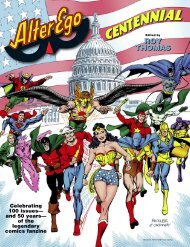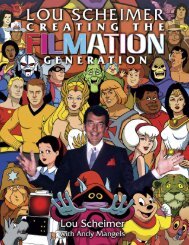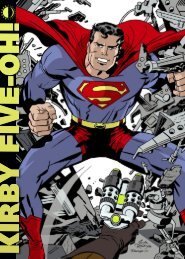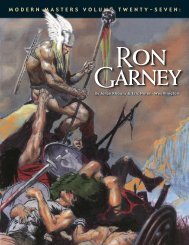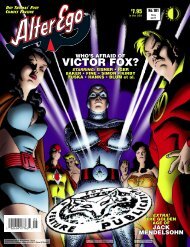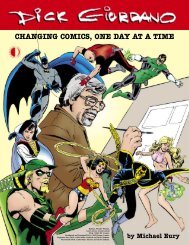Click above for a Flash preview, or download - TwoMorrows
Click above for a Flash preview, or download - TwoMorrows
Click above for a Flash preview, or download - TwoMorrows
Create successful ePaper yourself
Turn your PDF publications into a flip-book with our unique Google optimized e-Paper software.
Gallery 2 Hollywood Sequels<br />
e all know how, when Hollywood tries to turn a book into a film, <strong>or</strong> remake a classic, they always have to change things (and usually not <strong>f<strong>or</strong></strong> the better). So this issue, we<br />
W thought it only fitting to take a look at the <strong>or</strong>iginal 1940s-50s material New Y<strong>or</strong>k-centric Jack Kirby produced in a variety of genres, and how a much older, m<strong>or</strong>e mellow<br />
West Coast Kirby handled the same subject matter in the 1970s. (You’ve got to hand it to DC and Carmine Infantino; they let Jack try every genre he’d ever had success with,<br />
from Kid Gangs to Crime, and Romance to War and Mystery, trying to find the rec<strong>or</strong>d sales Simon & Kirby had in their heyday.) Which is better—the <strong>or</strong>iginal <strong>or</strong> the sequel?<br />
(this spread) Ahh, romance! But love<br />
is rife with pitfalls, such as the “true<br />
life” drama of being a carnival girl(?),<br />
in this page from True Love Problems<br />
#41 (Sept. 1956)—like most 1950s<br />
romance st<strong>or</strong>ies, this one had a<br />
happy ending. Contrast that to Jack’s<br />
w<strong>or</strong>k on the never-published True<br />
Div<strong>or</strong>ce Cases #1 (circa 1971 and<br />
<strong>or</strong>iginally produced <strong>f<strong>or</strong></strong> DC Comics),<br />
where the action—and relationship<br />
resolution—reach a decidely spicier<br />
tone.<br />
(pages 60-61) War! And nobody told<br />
a war st<strong>or</strong>y like Kirby! Whether it’s the<br />
1950s (like this unused Warfront<br />
cover, circa 1957) <strong>or</strong> the 1970s (Our<br />
Fighting F<strong>or</strong>ces #152, Dec. 1974), it<br />
didn’t matter what coast Jack lived<br />
on; it’s non-stop WWII action all the<br />
way!<br />
(pages 62-63) Oohh, spooky! You can<br />
see a 1951 full-st<strong>or</strong>y example of<br />
Kirby’s Black Magic w<strong>or</strong>k elsewhere<br />
in this issue, which is much m<strong>or</strong>e<br />
gripping than this tame cover <strong>f<strong>or</strong></strong><br />
Black Cat Mystic #58 (Sept. 1956).<br />
But when it came to mystery, the<br />
mellow vibe of the West Coast didn’t<br />
dull his ability to create creepy, suspenseful<br />
images, such as this page<br />
drawn <strong>f<strong>or</strong></strong> 1971’s Spirit W<strong>or</strong>ld #2 (and<br />
finally published in Weird Mystery<br />
Tales #3, Nov. 1972).<br />
(pages 64-65) Kids; you gotta love<br />
’em. And while Kirby temp<strong>or</strong>arily took<br />
the Newsboy Legion out of Suicide<br />
Slum in this page from Star-Spangled<br />
Comics #14 (Nov. 1942), this Kid<br />
Gang went all Hollywood high-tech<br />
with lots of new “gadgets” in<br />
Superman’s Pal Jimmy Olsen #144<br />
(Dec. 1971). One thing didn’t change<br />
over the years, however; Scrapper,<br />
the character most like Jack as a boy<br />
in New Y<strong>or</strong>k, is still the comic relief.<br />
(pages 66-67) Crime runs rampant<br />
in these examples, from the cover of<br />
Headline Comics #25 (July 1947),<br />
and from the unpublished In The<br />
Days Of The Mob #2 (circa 1971).<br />
Both show brutal images and beautiful<br />
women, and despite being drawn<br />
almost 25 years apart, stylistically<br />
they’re very similar.<br />
(pages 68-69) If Simon & Kirby ruled<br />
the 1940s super-hero genre with<br />
Sandman (from Adventure Comics<br />
#86, May 1943), DC figured they<br />
could recapture that popularity by<br />
reteaming Joe and Jack <strong>f<strong>or</strong></strong> Sandman<br />
#1 (Winter 1974). This new version of<br />
the character sold well initially (possibly<br />
due to a longer period on the<br />
stands), but the ongoing series only<br />
made it six issues (with a seventh<br />
shelved and later finally printed in<br />
Best of DC Digest #22 in 1982).<br />
58<br />
©1956 Harvey Publications.



